Demystifying Scroll's technology stack and deal flow
Author: francesco, Castle Capital;
On October 10, Scroll released a mysterious message announcing the launch of the mainnet. While I didn't fully realize there was more to it than just airdrop farming, I decided to delve into it.
Scroll is a scaling solution for Ethereum, which is an L2 general-purpose zero-knowledge (zk) rollup. Let’s take a closer look at this technology.
As an L2 rollup running on Ethereum, Scroll imports native ETH security.
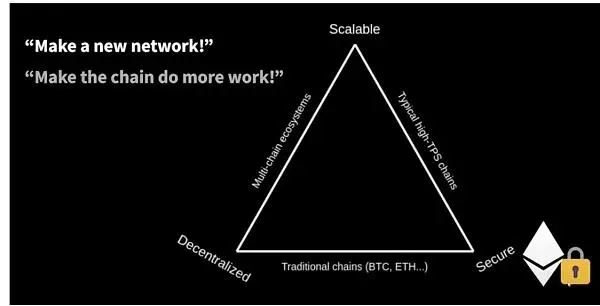
In addition to security, Scroll integrates seamlessly into the rich Ethereum ecosystem:
·Tools
· dApps
·Smart Contracts
·User Base
This approach enables effortless transfer and interchangeable use of these resources, ensuring unparalleled EVM compatibility. “For users and developers, Scroll is almost equivalent to Ethereum.”
Before the advent of Scroll, there was no universal zk rollup, mainly due to the calculation of generating zk for the Ethereum Virtual Machine (EVM) Proof complexity. Simply put, universal rollup is meant to have equivalent functionality to EVM.
However, successfully running an EVM environment on zk rollup has always been an elusive goal. This is due to the complexity of converting EVM transactions into logic circuits that can be explained through zk proofs. This complexity also explains why zk rollup projects only focus on specific applications, such as dYdX, which focuses on trading, and ImmutableX, which focuses on NFTs.
Due to technical difficulties, it is impossible to develop a universal network that can deploy various dAapps. This is also why zk-rollup performs poorly in terms of TVL and number of users compared to optimistic rollup (such as Immutable).
Despite these challenges, the search for universal zk rollup continues. Compatibility with EVM is important because it greatly simplifies the work required for developers to transition to the new chain.
The transition to a non-EVM chain means:
·Existing contracts must be migrated and rewritten to the new rollup.
·Not supported by existing EVM tools (libraries, wallets, markets, etc.).
·Unable to support applications from the Ethereum ecosystem.
Many rollups take on the task of universal zk EVM, with varying levels of EVM compatibility.
Comparison of the five major zkEVMs
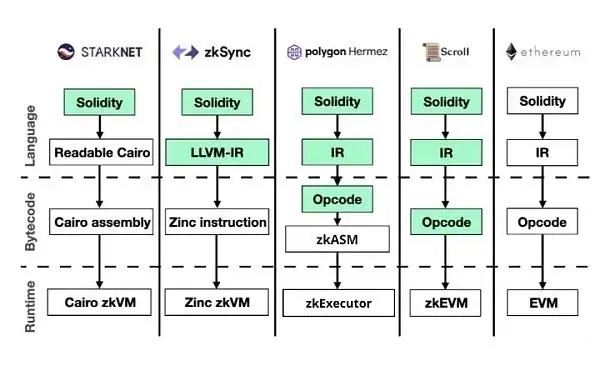
(1) Starknet and zkSync (language level):
These are currently using their own customizations A dedicated solution for running virtual machines (Cairo VM). They ran a custom VM and created a compiler, the "Warp Transpiler", that compiled Solidity code into Cairo VM bytecode.
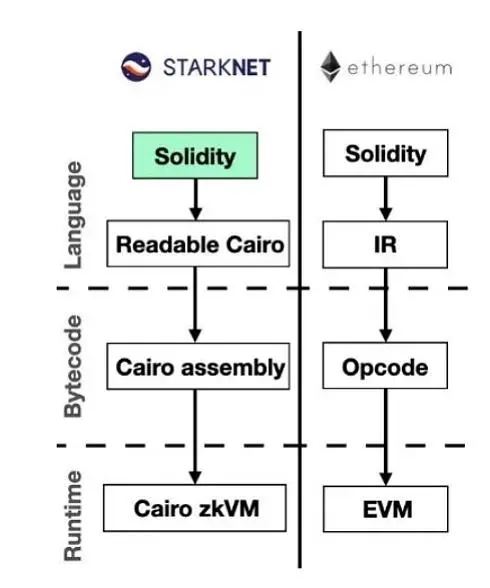
What they did was create a new VM and add Ethereum tool support on top as an extra layer. This still achieves the goal of exporting solidity contracts to StarkNet, thereby achieving "EVM compatibility".
Although not a direct EVM implementation, it retains compatibility and allows Solidity developers to write code for their rollups. This is a good compromise.
(2) Polygon zk-EVM (bytecode level):
Polygon runs a custom VM but has all EVM opcodes mapped to those valid for its VM. Polygon's approach is to build a zkEVM with "opcode-level equivalence".
Compared with Scroll, Polygon has an alternative runtime (runtime)-zkExecutor, which runs custom "zkASM" opcodes instead of running EVM opcodes directly. This is done to optimize EVM interpretation (since proving EVM directly would have too many limitations).
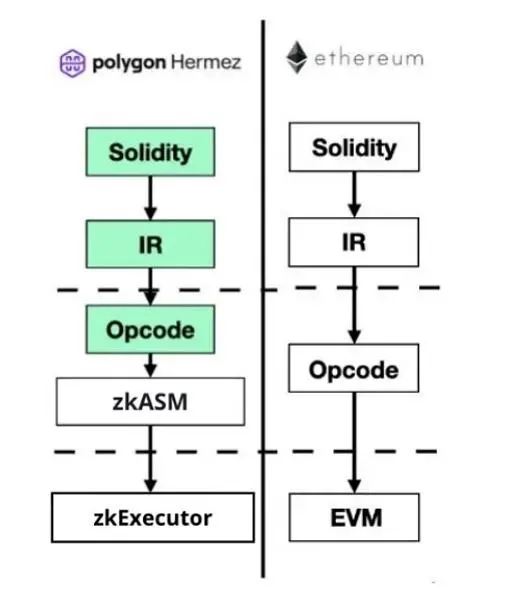
Here is a schematic diagram of this process:
While this configuration is more performant than Scroll, it adds a lot of custom code (to create zkASM ), introduces possible requirements to modify code or tooling to achieve compatibility, and may diverge more and more from Ethereum over time.
(3)Scroll (bytecode level):
Converts EVM execution directly into verifiable circuits, with advantages in tool support and compatibility. Currently, Scroll does not support all EVM opcodes, but they plan to eventually implement this over time.
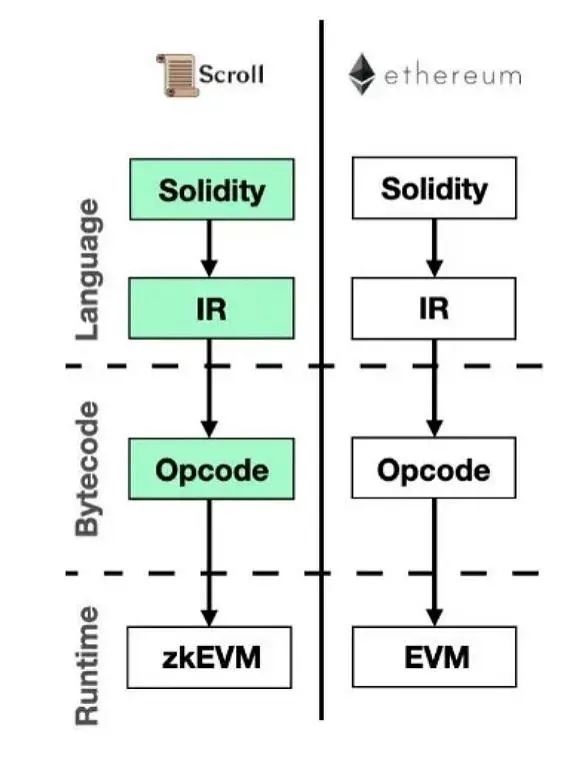
#How does Scroll’s technology stack work?
Scroll is a zk rollup. There is a smart contract on ETH L1. It is a zkEVM proof validator that can verify whether the Scroll protocol is safe.

How do transactions proceed on Scroll?
·Scroll can batch process blocks and write block data to Ethereum.
·Once a proof of validity is generated in a new block, the proof is written to Ethereum.
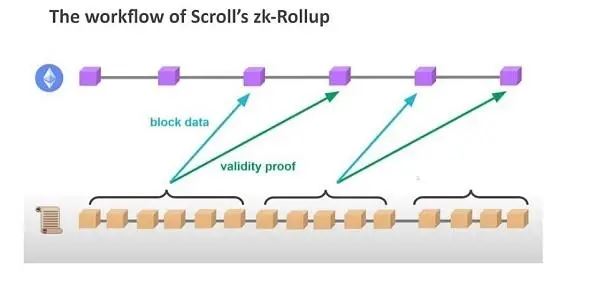
Therefore, a block on a Scroll can have three states:
· Pre-commit: proposed by the sequencer and included in the Scroll.
·Committed: Transaction data published on Ethereum
·Finalized: Correct execution has been confirmed by an on-chain validity certificate published on Ethereum.
The transaction process is as follows:
(1) Transactions flowing in from the sequencer are bundled and packaged in a block (1).
(2) The data and call data are submitted to the rollup contract on L1, and the block is submitted (D1).

(3) Proof generation: Pass the information to the coordinator (the "trace" of the completed work), and then pass it to the prover, who then generates the zk proof.
(4) Proof generation can occupy multiple blocks and can be executed in parallel by different "provers".
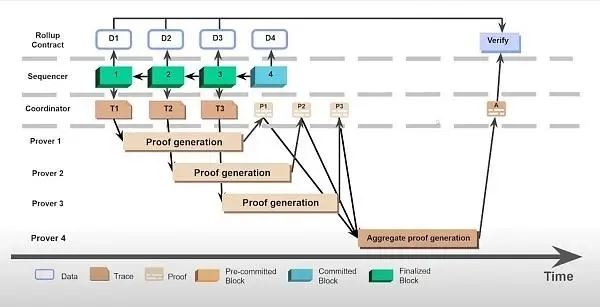
# (5) Aggregation proof generation: Proofs are generated and aggregated in batches, and then submitted to the chain for verification (Verify).
(6) The block is finalized.
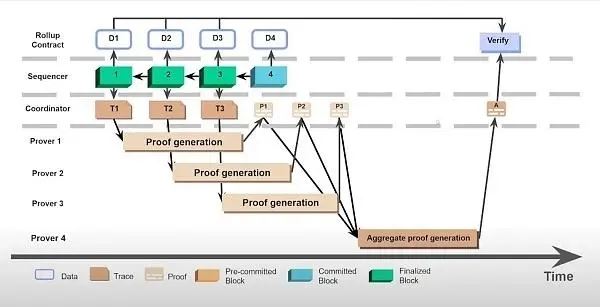
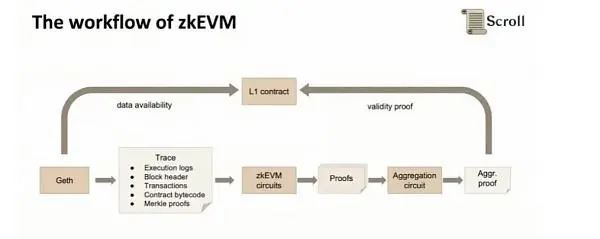



The above is the detailed content of Demystifying Scroll's technology stack and deal flow. For more information, please follow other related articles on the PHP Chinese website!

Hot AI Tools

Undresser.AI Undress
AI-powered app for creating realistic nude photos

AI Clothes Remover
Online AI tool for removing clothes from photos.

Undress AI Tool
Undress images for free

Clothoff.io
AI clothes remover

Video Face Swap
Swap faces in any video effortlessly with our completely free AI face swap tool!

Hot Article

Hot Tools

Notepad++7.3.1
Easy-to-use and free code editor

SublimeText3 Chinese version
Chinese version, very easy to use

Zend Studio 13.0.1
Powerful PHP integrated development environment

Dreamweaver CS6
Visual web development tools

SublimeText3 Mac version
God-level code editing software (SublimeText3)

Hot Topics
 1392
1392
 52
52
 36
36
 110
110
 Qubetics ($TICS): The Revolutionizing AI Crypto
Mar 23, 2025 am 10:08 AM
Qubetics ($TICS): The Revolutionizing AI Crypto
Mar 23, 2025 am 10:08 AM
Cryptocurrency has always been a realm where the cutting edge of technology meets bold ambition, and it's only getting more exciting in the future. As artificial intelligence continues to grow in influence, there are a handful of digital assets that
 Pi Network (PI) Price Falls Despite Successful PiFest 2025 Event
Apr 03, 2025 am 10:08 AM
Pi Network (PI) Price Falls Despite Successful PiFest 2025 Event
Apr 03, 2025 am 10:08 AM
Pi Network recently held PiFest 2025, an event aimed at increasing the token's adoption. Over 125,000 sellers and 58,000 merchants participated
 In Celebration of Pi Day, a Community of Pi Network Enthusiasts Held a Bartering Event in Muntinlupa City
Mar 22, 2025 am 10:02 AM
In Celebration of Pi Day, a Community of Pi Network Enthusiasts Held a Bartering Event in Muntinlupa City
Mar 22, 2025 am 10:02 AM
Pi Network Celebrates Pi Day with a Bartering and Merchant Orientation Event in the Philippines
 Where to download the genuine Ouyi? Official website download. Global
Mar 31, 2025 pm 02:09 PM
Where to download the genuine Ouyi? Official website download. Global
Mar 31, 2025 pm 02:09 PM
Ouyi usually refers to Ouyi OKX. The global way to download Ouyi OKX APP is as follows: 1. Android device: Download the APK file through the official website and install it. 2. iOS device: access the official website through the browser and directly download the APP.
 okx Ouyi Exchange web version enter link click to enter
Mar 31, 2025 pm 06:21 PM
okx Ouyi Exchange web version enter link click to enter
Mar 31, 2025 pm 06:21 PM
1. Enter the web version of okx Euyi Exchange ☜☜☜☜☜☜ Click to save 2. Click the link of okx Euyi Exchange app ☜☜☜☜ Click to save 3. After entering the official website, the clear interface provides a login and registration portal. Users can choose to log in to an existing account or register a new account according to their own situation. Whether it is viewing real-time market conditions, conducting transactions, or managing assets, the OKX web version provides a simple and smooth operating experience, suitable for beginners and veterans. Visit OKX official website now for easy experience
 RUVI AI (RUVI) Token Presale Might 20X After an Explosive Launch
Apr 03, 2025 am 11:08 AM
RUVI AI (RUVI) Token Presale Might 20X After an Explosive Launch
Apr 03, 2025 am 11:08 AM
The crypto market continues to face turbulence, with Cardano (ADA) dropping 12% to $0.64, prompting concern across the altcoin sector.
 What is Ouyi for? What is Ouyi
Apr 01, 2025 pm 03:18 PM
What is Ouyi for? What is Ouyi
Apr 01, 2025 pm 03:18 PM
OKX is a global digital asset trading platform. Its main functions include: 1. Buying and selling digital assets (spot trading), 2. Trading between digital assets, 3. Providing market conditions and data, 4. Providing diversified trading products (such as derivatives), 5. Providing asset value-added services, 6. Convenient asset management.
 BlockDAG Launches Beta Testnet With $200M Raised, Ethereum Approaches $2,000 & Tether Expands Into Media
Apr 03, 2025 am 10:34 AM
BlockDAG Launches Beta Testnet With $200M Raised, Ethereum Approaches $2,000 & Tether Expands Into Media
Apr 03, 2025 am 10:34 AM
Ethereum (ETH) price edges toward resistance, Tether news reveals a €10M media deal, and BlockDAG reaches new milestones with Beta Testnet and growing adoption.



